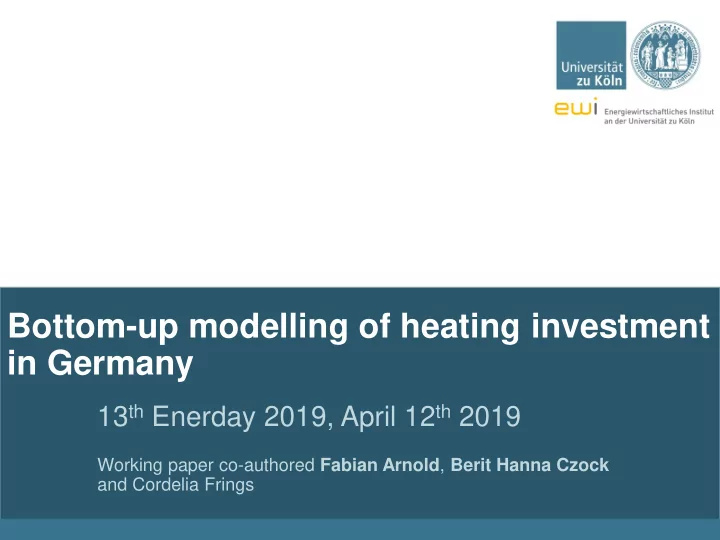

Bottom-up modelling of heating investment in Germany 13 th Enerday 2019, April 12 th 2019 Working paper co-authored Fabian Arnold , Berit Hanna Czock and Cordelia Frings
Bottom-up modelling of heating investment in Germany AGENDA I. Motivation II. Approach and Model III. Outlook and Challenges
I. Motivation
Background Motivation and Research Focus • Energy consumption of households accounts for roughly a quarter of the final energy consumption in Germany (UBA 2018). • Reducing GHG emissions in households may mean electrification of heat supply systems or investment in less GHG intense heating technologies. • Development of the heating and building infrastructure is the result of investment decisions of individuals. Therefore we propose a bottom-up approach based on the aggregation of individual choices to the total building stock German energy transition scenarios Research Focus accounting for individual household heating technology investment and operation decisions
Background Motivation and Research Focus • Energy consumption of households accounts for roughly a quarter of the final energy consumption in Germany (UBA 2018). • Reducing GHG emissions in households may mean electrification of heat supply systems or investment in less GHG intense heating technologies. • Development of the heating and building infrastructure is the result of investment decisions of individuals. Therefore we propose a bottom-up approach based on the aggregation of individual choices to the total building stock • How can individual choices be scaled up to a superordinate Research Focus level? • How can reciprocal effect between household decisions and the energy markets be modelled? • How can input information be condensed to address computational demands?
Literature – Existing Models Modelling of residential energy consumption Top-down Bottom-up e.g. Hirst 1978 Statistical Engineering based e.g. Fumo, Biswas 2015 Static Dynamic e.g. TABULA/EPISCOPE or Muratori et al. 2013 Exogenous decision making Endogenous decision making e.g. McKenna et al. 2013, Merkel et al. 2017 Bottom-up optimization of Empirical approaches individual decisions in a power market framework e.g. Hecking 2014, Müller 2015
II. Model
Approach Bottom-up optimization of individual decisions in an power market framework Data Data Data Bottom-up model Top-down model of individual of power market Aggregation decisions (DIMENSION) (COMODO) Price signals
Approach Bottom-up optimization of individual decisions in an power market framework Data Data Data Bottom-up model Top-down model of individual of power market Aggregation decisions (DIMENSION) (COMODO) Price signals
Modelling steps Economic optimisation of individual heating technology investment and operation Consumer Input COMODO Output Load profiles Installed capacities and • Electricity Total cost optimisation investment • Heating • Hot water Optimisation of invest Profiles of energy usage Generation profiles • Solar thermal Optimisation of storage Operation profiles • PV and technology operation Subsidies and fees • Feed in tariffs • Market premiums • Grid fees, taxes
Approach Bottom-up optimization of individual decisions in an power market framework Data Data Data Bottom-up model Top-down model of individual of power market Aggregation decisions (DIMENSION) (COMODO) Price signals
Modelling steps Aggregation • Definition of representative household types Building type No. of inhabitants Habitable area Region Building age Insulation level Rooftop area Installed technology • Scenario based constraints • Building replacement and demolition • Insulation rate • Technology development
Approach Bottom-up optimization of individual decisions in an power market framework Data Data Data Bottom-up model Top-down model of individual of power market Aggregation decisions (DIMENSION) (COMODO) Price signals
Modelling steps Integration with power market model in order to capture reciprocal effects • Soft coupling of consumer model and power market model • Iterative exchange of outputs • Optimal solution where models converge Demand Prices
Outlook
Challenges • Energy consumption of households accounts for roughly a quarter of the final energy consumption in Germany (UBA 2018). • Reducing GHG emissions in households may mean electrification of heat supply systems or investment in less GHG intense heating technologies. • Development of the heating and building infrastructure is the result of investment decisions of individuals. Therefore we propose a bottom-up approach based on the aggregation of individual choices to the total building stock • How can individual choices be scaled up to a superordinate Research Focus level? • How can reciprocal effect between household decisions and the energy markets be modelled? • How can input information be condensed to address computational demands?
Potential research spin-offs • How do regulatory changes affect the building stock in Germany? • RE support schemes/ surcharges • Grid fees • Taxes • How do market aspects (fuel costs, EU-ETS) affect the technology based decisions in the building stock in Germany? • Under what circumstances do certain technologies prevail? • How can emission and efficiency targets in the household heating sector be achieved?
Thank You! Questions?
References Umweltbundesamt, 2018. Endenergieverbrauch deutscher Haushalte. https://www.umweltbundesamt.de/daten/private-haushalte- konsum/wohnen/energieverbrauch-privater-haushalte. Last accessed on April 9 th , 2019. Hirst E., 1978. A model of residential energy use. Simulation 1978;30(3):69 – 74. Fumo, N., & Biswas, M. R., 2015. Regression analysis for prediction of residential energy consumption. Renewable and sustainable energy reviews , 47 , 332-343. Muratori M. et al., 2013. A highly resolved modeling technique to simulate residential power demand. Applied Energy Volume 107, July 2013, Pages 465-473. McKenna, R., Merkel, E., Fehrenbach, D., Mehne, S., Fichtner, W., 2013. Energy efficiency in the German residential sector: A bottom-up building-stock-model-based analysis in the context of energy-political targets. Building and Environment 62, 77 – 88. Merkel E., McKenna R., Fehrenbach D., Fichtner W., 2017. A model-based assessment of climate and energy targets for the German residential heat system. Journal of Cleaner Production Volume 142, Part 4, 20 January 2017, Pages 3151-3173. Hecking, H. (2015). Four Essays on the Economics of Energy and Resource Markets (Doctoral dissertation, Universität zu Köln). Müller, A., 2015. Energy Demand Assessment for Space Conditioning and Domestic Hot Water: A Case Study for the Austrian Building Stock. Dissertation, Technische Universität Wien, 2015.
Recommend
More recommend